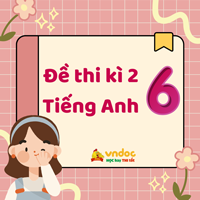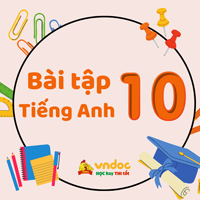Đề thi thử THPT Quốc gia năm 2017 môn Tiếng Anh có đáp án - Đề 43
Đề thi thử THPT Quốc gia năm 2017 môn Tiếng Anh có đáp án
"Học đi đôi với hành" sẽ giúp các bạn tiến bộ nhanh chóng trong tất cả các lĩnh vực. Đặc biệt, điều này luôn đúng cho các bạn thí sinh đang chuẩn bị bước vào kỳ thi TN THPT QG & ĐHCĐ năm nay. Hãy thử sức với bộ sưu tập Đề thi thử THPT Quốc gia năm 2017 môn Tiếng Anh có đáp án để nâng cao kiến thức và kỹ năng làm bài thi.
10 đề thi thử THPT Quốc gia năm 2017 môn Tiếng Anh trường THPT Nguyễn Tất Thành có đáp án
Bộ đề thi thử THPT Quốc gia năm 2017 môn Tiếng Anh CÓ ĐÁP ÁN - Số 4
Đề thi thử THPT Quốc gia năm 2017 môn Tiếng Anh THPT Chuyên Nguyễn Trãi, Hải Dương - Lần 2
Mark the letter A, B, C, or D on your answer sheet to indicate the word whose underlined part differs from the other three in pronunciation in each of the following questions.
Question 1. A. reduced B. dissolved C. supposed D. encouraged
Question 2. A. Encourage B. country C. ground D. young
Mark the letter A, B, C, or D on your answer sheet to indicate the word that differs from the other three in the position of primary stress in each of the following questions
Question 3. A. approach B. attract C. decent D. install
Question 4. A. verbal B. polite C. common D. social
Mark the letter A, B, C, or D on your answer sheet to indicate the underlined part that needs correction in each of the following questions.
Question 5. The disposable camera, a single- used camera preloaded with print film
A B C
has appeared in the late 1980s and has become very popular.
D
Question 6. Students suppose to read all the questions carefully and find out the answers to
A B C
them.
D
Question 7. Education can often to be considered to be the most important element to develop a
A B C D
country.
Mark the letter A, B, C or D on your answer sheet to indicate the correct answer to each of the following questions or the correct question to each of the following answers.
Question 8._______ colleges and _______ universities are the main institutions that provide tertiary education.
A. The/ Ø B. Ø/ the C. The/ the D. Ø/ Ø
Question 9. All my friends have big new electric bikes. I’m becoming____of my old Mini.
A. ashamed B. guilty C. embarrassed D. upset
Question 10. The making of good habits ______ a determination to keep on training your child.
A. require B. requires C. requirement D. required
Question 11. He was the only _______ that was offered the job.
A. apply B. application C. applicant D. applying
Question 12. Shy people often find difficult to__________ group discussion.
A. take part in B. get on with C. take place in D. get in touch with
Question 13. Last year she earned _______ her brother.
A. twice as much as B. twice more than C. twice as many as D. twice as more as
Question 14. Just keep________ on the baby while I cook the supper, will you?
A. a look B. a glance C. an eye D. a care
Mark the letter A, B, C or D on your answer sheet to indicate the sentence that is closest in meaning to each of the following questions.
Question 26. The sooner we solve this problem, the better it will be for all concerned.
A. If we can solve this problem soon, it will be better for all concerned
B. If we could solve this problem soon, it would be better for all concerned
C. If all concerned are better, we can solve this problem soon.
D. It would be better for all concerned if we can solve this problem soon
Question 27. The president arranged for me to use his car whenever I liked.
A. The president didn’t allow me to use his car.
B. The president put his car at my disposal
C. The president’s car was only used for at his disposal
D. Only when the president arranged was I allowed to use his car.
Question 28. “You took this CD without paying for it, didn’t you?”, the shopkeeper said to her.
A. The shopkeeper accused her of stealing the CD
B. The shopkeeper insisted her on taking the CD
C. The shopkeeper gave her the CD
D. The shopkeeper told that she could get the CD for free.
Mark the letter A, B, C or D on your answer sheet to indicate the sentence that best combines each pair of sentences in the following questions.
Question 29. I’m sure it wasn’t Mr Phong you saw. He’s in Hanoi.
A. It couldn’t be Mr Phong you saw because he’s in Hanoi
B. You must have seen Mr Phong because he’s in Hanoi
C. It can’t have been Mr Phong you saw because he’s in Hanoi
D. Mr Phong mightn’t see you because he’s in Hanoi
Question 30. I did not read his book. I did not understand what the lecturer was saying.
A. What the lecturer wrote and said was too difficult for me to understand.
B. I found it very difficult to understand what the lecturer said in his book.
C. I would have understood what the lecturer was saying if I had read his book.
D. The lecturer’s book which I had not read was difficult to understand.
Read the following passage and mark the letter A, B, C, or D on your answer sheet to indicate the correct word or phrase that best fits each of the numbered blanks from 31 to 35.
In the western customs (31) _____ hands is the customary form of greeting, but in China a nod of the head or slight bow is sufficient. Hugging and kissing when greeting are uncommon. Business cards are often (32) _____ and yours should be printed in your own language and in Chinese. Also, it is more respectful to present your card or a gift or -any other article using both hands. The Chinese are (33) _____ applauders. You may be greeted with group clapping, even by small children. When a person is applauded in this practice it is the custom for that person to return the applause or a "thank you." When walking in public places, direct eye contact and staring is uncommon in the larger cities, especially in those areas accustomed to foreign visitors. (34) _____, in smaller communities, visitors may be the subject of much curiosity and therefore you may notice some stares. Generally speaking, the Chinese are not a touch-oriented society, especially true for visitors. So, avoid (35) _____ or any prolonged form of body contact. Public displays of affection are very rare. On the other hand, you may note people of the same sex walking hand-in-hand, which is simply a gesture of friendship. Do not worry about a bit of pushing and shoving in stores or when groups board public buses or trains. In this case, Apologies are neither offered or expected. The Chinese will stand much closer than Westerners.
Question 31. A. taking B. shaking C. grasping D. hugging
Question 32. A. exchanged B. changed C. transferred D. converted
Read the following passage and mark the letter A, B, C or D on your answer sheet to indicate the correct answer to each of the questions from 36 to 42.
Increasing numbers of parents in the U. S. are choosing to teach their children at home. In fact, the U.S. Department of Education has estimated that in 1999, about 850,000 children were being homeschooled. Some educational experts say that the real number is double this estimate, and the ranks of homeschooled children seem to be growing at the average rate of about eleven percent every year.
At one time, there was a theory accounting for homeschooling: it was traditionally used for students who could not attend school because of behavioral or learning difficulties. Today, however, more parents are taking on the responsibility of educating their own children at home due to their dissatisfaction with the educational system. Many parents are unhappy about class size, as well as problems inside the classroom. Teacher shortages and lack of funding mean that, in many schools, one teacher is responsible for thirty or forty students. The children are, therefore, deprived of the attention they need. Escalating classroom violence has also motivated some parents to remove their children from school.
Although there have been a lot of arguments for and against it, homeschooling in the U.S. has become a multi-million dollar industry, and it is growing bigger and bigger. There are now plenty of websites, support groups, and conventions that help parents protect their rights and enable them to learn more about educating their children. Though once it was the only choice for troubled children, homeschooling today is an accepted alternative to an educational system that many believe is failing.
Question 36: The past participle “homeschooled” in the first paragraph is best equivalent to “_____ at home”.
A. taught B. self – learned C. untaught D. self-studied
Question 37: This estimated number was presented by ________
A. a governmental office B. school teachers
C. the parents D. homeschooled children
Read the following passage and mark the letter A, B, C, or D on your answer sheet to indicate the correct answer to each of the questions from 43 to 50.
Today's cars are smaller, safer, cleaner and more economical than their predecessors, but the car of the future will be far more pollution-free than those on the road today. Several new types of automobile engines have already been developed that run on alternative sources of power, such as electricity, compressed natural gas, methanol, steam, hydrogen, propane. Electricity, however, is the only zero-emission option presently available.
Although electric vehicles will not be truly practical until a powerful, compact battery or another dependable source of current is available, transportation expects foresee a new assortment of electric vehicles entering everyday life: shorter-range commuter electric cars, three-wheeled neighborhood cars, electric deliver vans, bikes, and trolleys.
As automakers work to develop practical electric vehicles, urban planners and utility engineers are focusing on infrastructure systems to support and make the best use of the new cars. Public charging facilities will need to be as common as today’s gas stations. Public parking spots on the street or in commercial lots will need to be equipped with devices that allow drivers to charge their batteries while they stop, dine, or attend a concert. To encourage the use of electric vehicles, the most convenient parking in transportation centers might be reserved for electric cars.
Planners foresee electric shuttle buses, trains and neighborhood vehicles all meeting at transit centers that would have facilities for charging and renting. Commuters will be able to rent a variety of electric cars to suit their needs: light trucks, one-person three-wheelers, small cars, or electric/gasoline hybrid cars for longer trips, which is no doubt take place on automated freeways capable of handling five times number of vehicles that can be carried by a freeway today.









